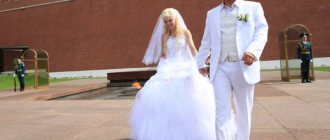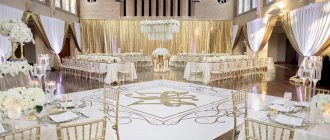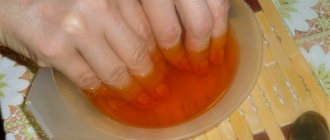Towel for loaf. What is this?
What is called a towel in Russia, in the Ukrainian version sounds like “rushnik” : from the word “to destroy”, “to tear”. There is another meaning of the word – “to move”, so the ritual towel among the Eastern Slavs is a symbol of the path.
The towel has always been a mandatory attribute of a wedding , as it became the personification of a successful path into family life. Today it is a decorative element into which newlyweds continue to invest sacred meaning.
Story
This ancient accessory appeared long before the Christianization of Rus'. It was believed that by embroidering certain patterns on a linen or canvas piece of fabric, one could protect Rod from the evil eye. Such a talisman for the family promised prosperity, fidelity, health, and the birth of children. There was a special approach to wedding towels.
Initially, the future bride was required to embroider up to 40 ritual towels with her own hands. They were given to matchmakers, guests - at the time of matchmaking, at a long marriage ceremony (a wedding in some regions could be celebrated for a week).
Below, in the “Types of towels” section, we will analyze the types of towels and answer the questions - which towel is needed for an icon, and which one is needed when meeting young people with a loaf of bread.
This is interesting! There was a certain minimum. The girl had to embroider at least 12 towels . The rest was done by the women of her family - so that they would not think that the potential wife was lazy and impatient. The most magnificent in decoration and abundance of design was the towel for the loaf.
Embroidery pattern for a wedding towel
The variety of towels during a wedding event indicates the great ethnic role of the towel at every stage: from matchmaking to wedding. In the old days, it was believed that the bride had to embroider towels and outfits with her own hands. Once upon a time, the number of towels used at a wedding ceremony reached 40 pieces.
Today the number of towels has been reduced to 5-6:
- wedding - spreads under the feet of the newlyweds in church, registry office,
- allied towel - their hands are tied,
- “godniks” - two towels are used for icons,
- towel for the Gospel,
- a hospitable towel - a loaf is placed on it.
One of the main ones is the towel, which the newlyweds stand on during the wedding ceremony and painting. According to beliefs, it was believed that it should be long, because its length is a symbol of life together. The towel must be white; this color speaks of sincerity, honesty, and trust. Previously, they even embroidered such a towel with white threads so that life together would be bright.
The drawing should be beautiful, rich, then the couple’s life will be rich and bright. Opinions differ on the issue of the pattern of the towel, which is laid under the feet. Modern copies often contain wedding symbols - wishes, doves, rings. In the old days, it was believed that it was not worth using such symbols, because young people, when they stood on the towel, could trample on the good moments in their lives. Therefore, most often such towels had neutral motifs: floral, geometric patterns.
Types of towels
Today, the number of wedding accessories has been simplified, leaving 6 mandatory varieties of sacred cloth. They accompany the key moments of the wedding:
- “hand-beaten” towel was given to the future parents of the groom. If the girl refused, she gave her a pumpkin; if she agreed, she gave her an embroidered towel.
- “The Blessed Ones” adorned icons with which parents instructed young people to live together in love and fidelity.
- A towel under the feet symbolized the beginning of a new life.
- The “allied” bandaged the hands of the bride and groom as a sign of unity. This tradition used to replace what wedding rings are made today.
- The “God’s” sacred cloth was intended to decorate the icons that the newlyweds held during the wedding.
- “hospitable” towel is the embodiment of wishes for prosperity and well-being. His embroidery differs from the rules for applying patterns.
The key role of the accessory is to attract wealth and demonstrate respect for another wedding shrine, the loaf.
Only women who were happy in their married life kneaded it, so no one else was allowed to take the wedding bread with their hands, it was considered a bad omen.
The loaf-style canvas is distinguished by lush patterns, inscriptions that come from antiquity, such as “Bread and Salt ,” and modern ones, for example, “Advice and Love!” .
Important! Previously, more attention was paid to this type of ritual towels: married couples were created not so much on the basis of mutual feelings, but on the material security of the other half. Thus, unmarried girls did not skimp on the beautiful design of the canvas, and the word “love” itself was not embroidered; it was embodied by a special ornament in the form of paired birds or flowers.
What should a traditional towel be like?
A towel for wedding bread looks like a piece of fabric, in the center of which there should be a loaf. The size of the accessory can be from 42 centimeters to 1.5 meters . The central part of the accessory remains free of embroidery. One fourth of the canvas on the left and right is occupied by patterns and inscriptions with wishes.
Since most modern couples at a wedding ceremony limit themselves to only a wedding towel for a loaf, the canvas is decorated with any embroidery: beads, wishes, symbols of marriage, roses, etc. .
In the photo and pictures below, examples of different options for towels for wedding bread and salt:
Towel under your feet
He is perhaps the most important person at the wedding ceremony, because it is he who decides how the future life of the new family will turn out. In the registry office during the marriage process or in the church during the wedding, witnesses spread a “wedding” white towel on the floor in front of the newlyweds, on which they stood. The center of the cloth should remain white, thereby personifying the connection with the cosmos. The towel symbolized a white cloud on which the bride and groom seemed to ascend to the Kingdom of Heaven, where the Lord himself blessed their marriage and sealed it with the sacred bonds of marriage. Therefore, it is forbidden to embroider rings, flowers, the wish “For good luck!”, or two birds symbolizing the newlyweds on it, because when the bride and groom stand on such a towel, they will trample on everything good that could be in their family future. The best option for embroidery on a wedding towel is a floral ornament or a geometric pattern. If a girl decides to embroider a towel by hand, then under no circumstances should her mother or sister help her, otherwise her son-in-law will be turned away (discouraged).
How to choose?
From whom to order a towel for a loaf (from a company or from a familiar embroiderer) is an individual question. The price of the work may not differ.
When choosing, follow simple principles:
- Towels with a colorful print should not smell like paint ;
- It is better to purchase from the moment you submit your application to the registry office. There are 2 explanations for this. Firstly, the bride will have other worries. Secondly, there is a possibility that the production of this accessory will have to wait a long time. We must take into account the seasonality of weddings;
- They don’t take used towels, which is considered a bad omen.;
- It is important that the length of the product is divided into 7 equal parts - this is required by custom.
Brides should take into account that the main advantage of a factory-made product is the guaranteed accuracy of the pattern on both sides. However, only a towel that has been custom embroidered by a master can be unique.
Sizes of towels
According to tradition, the size of a wedding towel is divided by 7 without a remainder. The length is divided into three equal parts and the middle, one third, must be left white. Nowadays, few people adhere to this rule and choose a white canvas 2 to 3 m long for towels “under the loaf” and “under the feet”. But in the center there must be an empty space for the bride and groom to step into, and plus the rule of the design quarters of the towel, so the length in width is from 45 to 50 cm. The width of the towel is determined by repeating the pattern, and the length is determined by the amount of embroidery (the free space in the middle should be enough for the feet of the newlyweds). The towel is hemmed by hand, grasping the base thread through the cross, so that a dotted line is created on the face only if a fabric without an edge is used for it. The hem depends on the fabric, for example, calico or linen is folded 0.5 cm 2 times. The design should be symmetrical and there should be no white border on the sides. The sizes of towels “for icons” and “union” are: length from 1.8 to 2 m, and the width of the towel depends on the pattern.
We recommend that you read:
Wedding towel and embroidery symbols
Towel for a wedding: what to do with a towel after the wedding
How much does it cost?
The price range for these accessories starts from 150 rubles on average (in Moscow) - this is color printing on a textile product, and from 300 - 700 rubles .
The splendor of the design, the quality and length of the canvas, and the fame of the manufacturer affect its cost. You can buy a towel for a loaf from a clothing factory for 1300 – 1800 rubles . When placing an order, production times are taken into account. Machine embroidery is done faster ( from 3 to 7 days , if it is not the height of the wedding season).
The meaning of the towel
A wedding towel is an indispensable element during a wedding. It is used during wedding ceremonies and for meeting newlyweds after the registry office. A towel is a decorative embroidered towel, usually made of linen, cross-stitched or satin stitch, and decorated at the bottom with lace or fringe made of the same fabric.
The wedding towel takes place in many Slavic rites, and the name of the matchmaking ritual in various regions is associated with it. It is called giving towels, taking, giving or simply towels. They are an invariable attribute of matchmaking and symbolize the girl’s consent to marriage. They tie it around matchmakers or offer bread on a towel. In some areas, the tradition of the betrothal ceremony has been preserved, during which the bread is covered with a towel and all relatives who take part and the young people put their hands on the towel, and the headman ties them with a symbolic knot, accompanying his actions with special words. After this, the knot is untied, and the matchmakers are tied with towels and given gifts. A young family must keep a wedding towel for the rest of their lives.
Types of towels and their purpose
This main symbol is always used at the ceremony, denoting the joint life path of the newlyweds. According to popular belief, it represents the key to a strong family. Images and drawings carry various magical meanings, protect the hearth and protect the family.
For the traditional Ukrainian ritual, more than 40 varieties of towels were required. The modern wedding process involves the presence of 5 canvases, differing in purpose, design and method of application.
Hospitable towel for a loaf of bread for a wedding
The product is one of the most striking traditional items of Ukrainian celebration. A festive loaf is placed on it, with which the parents greet the couple after the wedding or painting. This type of textile does not contain any restrictions on execution.
On the sides of the hospitable cloth there are images of a pair of birds. Doves, larks, and peacocks symbolize those getting married who have decided to be faithful to each other throughout their lives. Floral combinations, plexuses of leaves, tree branches and plants are embroidered on canvas as a sign of well-being, prosperity and health.
Union towel - for tying the hand of the bride with the hand of the groom
This towel is used to tie the hands of a guy and a girl in the registry office or during the wedding sacrament. It means:
- unity;
- attachment;
- common path;
- happy future life;
- the strength of the lovers' relationship.
The names of the spouses, flower painting, doves, swans, wishes of happiness and love were embroidered on the union towel. It has long been believed that embroidery with white threads will provide newlyweds with a cloudless, bright and calm future. An ornament made with red threads will give joy to young people.
Large table towels for weddings
On the festive table you can often see fabric table runners with various embossing. They are made from calico, waffle, cotton fabric, canvas. Popular images that decorate table towels:
- rose - beauty, rebirth;
- lily - purity;
- malva - chastity;
- viburnum - endurance, fertility;
- oak - vitality, energy, power;
- swallow - good;
- rooster - hard work, wealth.
Depending on the style of execution and theme of the patterns, towels used to decorate the table contain red, blue, scarlet, burgundy, green, and white colors.
Towel for wedding under feet
It is believed that by stepping on birds, you can trample your cloudless future and marriage. The couple should also avoid items with hemlines and lace elements. An excellent option for a wedding would be a panel embossed with flowers, trees or geometric shapes.
Popular herbal compositions:
- hop leaves - youth, riot of joy;
- acorns intertwined with viburnum branches - fidelity of spouses;
- grapes - fertility, prosperity and wealth;
- poppy - prosperity, longevity, good health.
It is customary to keep an embroidered towel as a valuable family talisman.
Bozhnik, or blessed towel for a wedding icon
The Bozhnik is a small towel for images that parents use to bless their children before marriage. It is distinguished by rich and original embroidery, where the red color predominates as a sign of joy.
On the parental icons, flowers, leaves of trees, shrubs, and a varied combination of geometric figures are depicted for images. For the bride, the blessed towel is embroidered with roses, hollyhocks, and viburnum branches. The groom's towel is depicted with oak leaves and grapes.
Wedding towel
It was believed that everything in a towel was important: from the embroidered design to the thoughts and feelings of the needlewoman that arose while she was working. For example, if a girl experienced negative emotions while embroidering, then such a towel will only bring trouble to the newlyweds’ family
Therefore, even now, most brides prefer to make their own towels rather than buy them.
But this work is labor-intensive and can take a long time. For example, if you follow traditions, then one towel will not be enough. Quite a lot of them are required:
- a white towel is laid in front of the newlyweds during marriage registration;
- another one goes under the icon, symbolizing parental blessing;
- during the blessing, the parents hold the bread on a different towel;
- a new loaf is required for the wedding;
- the hands of the young people are also tied with a towel;
- Several towels are needed to decorate the table.
And many more other points. Of course, the bride can do everything on her own or ask her mother for help. Moreover, towels embroidered by the mother were more valued.
Video: DIY towel embroidery for a wedding
The basis of any towel is white fabric. According to tradition, the center of the product should remain empty, and the designs on the edges and sides can be either the same or different in color and style. The main thing is that everything is balanced. Special fabric for embroidery can be purchased at needlework stores. The video shows options on where to start embroidering a towel. There are tips on what mistakes may be made in the work. Diagrams, photos, stories and user stories will help you navigate and tune in when working.











